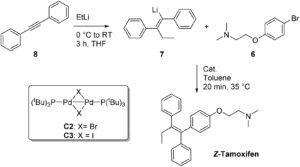We are delighted to welcome Dr Elizabeth Krenske to the OBC team as an Associate Editor. Elizabeth is an Associate Professor at the University of Queensland, Australia, where her research focuses on the computational study of organic reactions and modelling of drug molecules and interactions.
After starting out her career in chemistry as an undergraduate at the University of Queensland, Elizabeth undertook a PhD in the field of synthetic main-group chemistry at The Australian National University’s Research School of Chemistry, under the supervision of Professor S. Bruce Wild. She spent a further two years carrying out postdoctoral research at the Australian National University, before receiving a Fulbright Scholarship and commencing postdoctoral studies at UCLA with Ken Houk. Elizabeth returned to Australia in 2009 as an Australian Research Council (ARC) Australian Postdoctoral Fellow at the University of Melbourne, and moved to The University of Queensland in 2012 as an ARC Future Fellow. She is currently an Associate Professor and Strategic Research Fellow in the University of Queensland School of Chemistry and Molecular Biosciences. To find out more about Elizabeth and her research, visit her webpage or browse some of her recent publications below.
Elizabeth’s recent publications:
The fate of copper catalysts in atom transfer radical chemistry
Polym. Chem., 2019, 10, 1460-1470
Asymmetric synthesis of multiple quaternary stereocentre-containing cyclopentyls by oxazolidinone-promoted Nazarov cyclizations
Chem. Sci., 2018, 9, 4644-4649
Synthesis of spirocyclic orthoesters by ‘anomalous’ rhodium(II)-catalysed intramolecular C–H insertions
Org. Biomol. Chem., 2018, 16, 256-261
Claisen rearrangements of benzyl vinyl ethers: theoretical investigation of mechanism, substituent effects, and regioselectivity
Org. Biomol. Chem., 2017, 15, 7887-7893
An unprecedented stereoselective base-induced trimerization of an α-bromovinylsulfone
Org. Biomol. Chem., 2017, 15, 5529-5534












